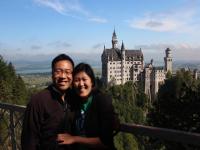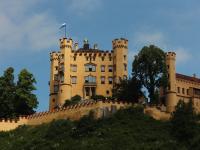Profile
Blog
Photos
Videos
Hotel Altstadt Zum Hecthen, what can I say? Pete booked this hotel on a Rick Steve's tip, and it was fantastic! Quaint, solid comfortable beds, fluffy down pillows and thick down comforters. No a/c, but Fuessen was a breath of fresh air compared to Munich - cooler and less 'polluted'.
We arrived the night before and champed our steadily growing luggage up the 4 small flights of stairs. Cristine, one if the owners, was skeptical that we could do it at first, but I grabbed my luggage and followed Pete up with his luggage. I found out that the place is family owned and run by 2 families, and breakfeast was included with our stay - nice!
This morning, we woke up at 7 in order to have breakfast and be on time for our reserved tickets to the castles! But before the castles, I need to mention the great spread put out by the hotel. Coffee or tea at your request, multiple kinds of juices - even papaya and berry? A large variety of breads, meats, cheeses, cereals, and best of all brown hard boiled eggs! I had been missing eggs most of this trip, especially for breakfast, so I was in heaven! Brown, perfectly boiled eggs. All the food looked and tasted like very good quality stuff, not just some slab of bread here and packaged cheese. Oh! The food was so good, we decided to check out the hotel's restaurant for dinner. More on this later.
Our stomachs sated, we drove out to Hohenschwangau and Neuschwanstein castles. It was foggy with a forecast of 21 degrees, a bit of drizzle. I used my good judgment and wore capris and flats. At least Pete had the foresight to reserve our tickets online before we left for our trip. We arrived at the ticket office early, an hour and a half before our tour, and the man let us go on the earlier tours.
Hohenschwangau, was originally built as a fortress in the 1200s, but was destroyed by Napoleon. King Maximillian came by on a hunting tour and liked the location, so he decided to build a summer home there, you know, no big deal. This summer home became Hohenschwangau, meaning Highland of the Swans. The town beneath was called Schwangau, to describe the swans in the area.
We immediately walked the 10 minutes to get to Hohenschwangau in order to take picture of the exterior before the tour started. The castle was stuccoed yellow and had a red tiled roof. The courtyard had many fountains and a good view of the village. Our tour started at 9:20, and we walked through the billiards room, dining room and the king and queen's apartments and saw pictures of the royal family. The rooms in this castle were kept quite original. The only things that were changed were in the king's room, where Ludwig painted over the ceiling with a night sky, complete with translucent stars and a moon with a swivel cover to imitate the waxing and waning of the real moon. Leopold, Ludwig's uncle then undressed the ladies in the room's murals when he was in power. He would be the last of the Wittelsbach family to live there.
Our tour only took 1/2 an hour, so we had about 1.5 hours until the Neuschwanstein tour. We found out afterwards, that we needed that much time in between. When we walked the 10 minutes back to the ticket booth, the steep hike up to Neuschwanstein would've taken 30-40 minutes. Being in flats, and in the interest of saving time, we opted to pay the ~ 4€ bus fare to go up to the viewing point. In hindsight, this was an excellent choice. Pat on the back. We got dropped off at Mary's Bridge, the best view of the castle; however, everything was fogged over! We turned around and hiked the remaining 10 minutes up to the castle to take pictures of it before the tour started. There, we were met by a bunch of Asian Tourists, but I guess this was some big special group, b/c they had professional photographers and videographers with them. In fact, one of the guys I asked to help take a picture of us was one of their photographers on the job - score!
Our tour took us up to the 2nd floor of the castle - the servants quarters. Pretty nice digs. Then, we climb more stairs up to the 4th floor to the king's apartments. The woodwork in King Ludwig's bedroom alone took 12 carvers 4 years to complete. If you saw the intricacy in the work, you would understand why. He also had a leather cushioned toilet and running water vowing out of his gigantic pewter swan faucet! Okay, maybe he wasn't insane but he sure was extravagant.
We also saw a life sized swan statue that was used as a humidifier and the opulent throne room located on the unfinished 3rd floor. Unfortunately, much of this castle is unfinished, and in fact, King Ludwig himself only spent 172 days in it. The last room we saw was the kitchen, which was huge, and well stocked with gleaming pots and pans.
After the tour, we paid €6 for a carriage ride back down (1/2 the price of going up!) and happily sat back and snapped pictures while watching people hiking uphill look at us enviously. We grabbed a bite to eat at the Brau Strubel back in town - a very slow and slightly poor set up, and rushed out of the area to go to Schloss Linderhof.
But on the way, we stopped by Oberammergau to check out its famous woodcarvings. This little town has a lot of woodcarving stores, mostly of traditional religious figures (creepy) and of course, the bigger the piece, the more costly. We opted for some cute little animal figures and a few other souvenirs instead.
We continued on our way to Schloss Linderhof, another of King Ludwig II's castles. You know, b/c he built them like legos :) this one was 'smaller' compared to the two we saw this morning. It was beautifully set with gardens and fountains on either side of the property. The palace itself was built in the style of the palace of Versailles because Ludwig admired Loius IV. The wrought iron was reminiscent of the gates in Versailles, and many of the statues and rooms mimicked Versailles as well. Inside, the second floor was a a series of rooms that led into each other, ging in a in a circle. Each room was quite small, with the largest being the bedroom with a bed sectioned off for guest viewing. This room also faced the large fountain and water flowing into the fountain. The reading room was dubbed the mirror room to mimic the hall of mirrors in Versailles, except it wasn't a hall - the effect of the multiple mirrors was accomplished by placing two large mirrors in front of each other, so when you stood in between the two, it appeared as if the mirrors were never-ending! The dining room had a very small table because the king was reclusive. But this dining table could be lowered and raised by a pulley system, so when the king wanted to each, he would pull a lever to lower the table to be set, and when the servants were done setting and placing the dishes on the table, they would raise the table back up to the second floor.
After the indoor tour, we hiked up to see the king's grotto. This cave is Europe's biggest artificial grotto. The whole structure lookes like a cave, but is man made and heated. It has an artificial lake and a swan boat for the king to float in while listening to Wagner operas. If he so desired, his servants would place different colored glass over the lights to create different moods in the grotto.
After Linderhohf, we drove back to Fuessen via the Plansee and enjoyed the view of the mountains and the colours of the water. We arrived back at the hotel in time for dinner, and it since it smelled so good in the restaurant, we decided to stay there for dinner. This turned out to be a great choice because the food was 'lecker' (yummy) and here, I discovered my favorite German drink, Radler! This drink is a mix of beer and Lemonade, and all deliciousness.
- comments







